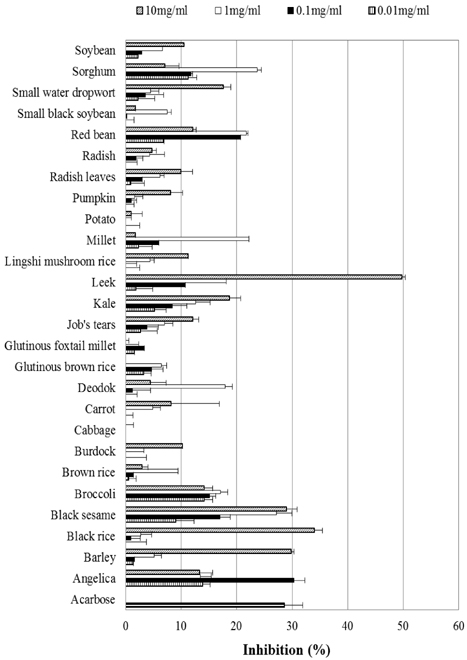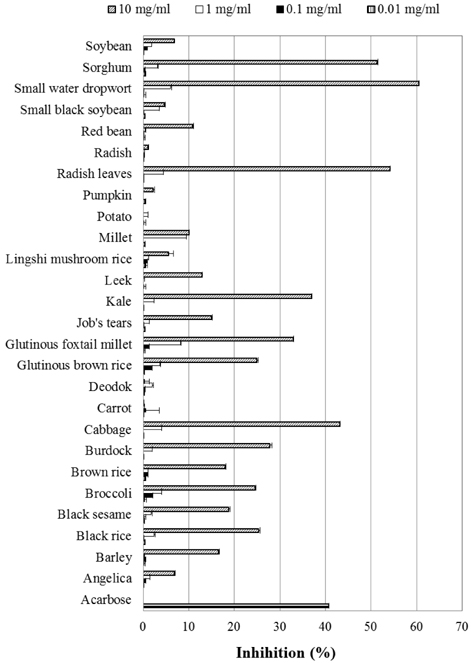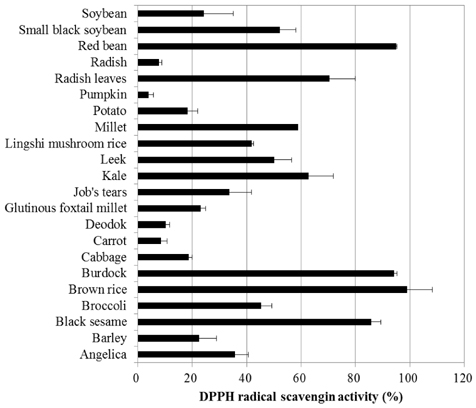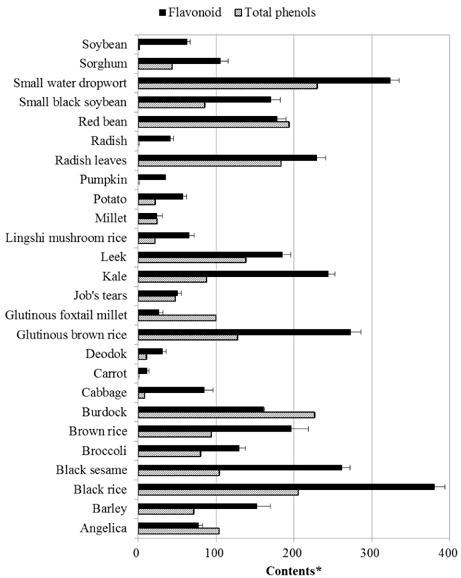Nutr Res Pract.
2014 Oct;8(5):602-606. 10.4162/nrp.2014.8.5.602.
The ingredients in Saengshik, a formulated health food, inhibited the activity of alpha-amylase and alpha-glucosidase as anti-diabetic function
- Affiliations
-
- 1Department of Food Science and Nutrition, Dankook University, 152 Jukjeon-ro, Suji-gu, Yongin, Gyeonggi 448-701, Korea. yjeong@dankook.ac.kr
- 2Institute of Global Food Industry, Dankook University, 152 Jukjeon-ro, Suji-gu, Yongin, Gyeonggi 448-701, Korea.
- KMID: 2313785
- DOI: http://doi.org/10.4162/nrp.2014.8.5.602
Abstract
- BACKGROUND/OBJECTIVES
We investigated total 26 ingredients of Saengshik which will be commercially produced as an anti-diabetic dietary supplement.
SUBJECTS/METHODS
Thirteen vegetables, nine cereals, three legumes and one seed were extracted with aqueous ethanol for 2 h at 60degrees C, and evaluated for their inhibitory effects against alpha-amylase and alpha-glucosidase and for total phenolic and flavonoid contents.
RESULTS
All ingredients inhibited alpha-amylase activity except cabbage. Strong inhibitory activity of alpha-amylase was observed in leek, black rice, angelica and barley compared with acarbose as a positive control. Stronger inhibition of alpha-glucosidase activity was found in small water dropwort, radish leaves, sorghum and cabbage than acarbose. All Saengshik ingredients suppressed alpha-glucosidase activity in the range of 0.3-60.5%. Most ingredients contained total phenols which were in the range of 1.2-229.4 mg gallic acid equivalent/g dried extract. But, total phenolic contents were not observed in carrot, pumpkin and radish. All ingredients contained flavonoid in the range of 11.6-380.7 mg catechin equivalent/g dried extract.
CONCLUSIONS
Our results demonstrate that Saengshik containing these ingredients would be an effective dietary supplement for diabetes.
Keyword
MeSH Terms
Figure
Reference
-
1. Vinik AI, Maser RE, Mitchell BD, Freeman R. Diabetic autonomic neuropathy. Diabetes Care. 2003; 26:1553–1579.
Article2. World Health Organization. Diabetes [Internet]. Geneva: World Health Organization;2012. cited 2012 Dec 4. Available from: http://www.who.int/mediacentre/factsheets/fs312/en/.3. Bhandari MR, Jong-Anurakkun N, Hong G, Kawabata J. α-Glucosidase and α-amylase inhibitory activities of Nepalese medicinal herb pakhanbhed (Bergenia ciliata, Haw.). Food Chem. 2008; 106:247–252.
Article4. Ministry of Food and Drug Safety (KR) Korean food standards codex [Internet]. Cheongwon: Ministry of Food and Drug Safety;2012. cited 2012 Dec 4. Available from: http://fse.foodnara.go.kr/residue/RS/jsp/menu_02_01_03.jsp?idx=96.5. Hwang JK. Function of uncooked foods. Food Ind Nutr. 2002; 7:16–19.6. Kim HY, Kim JH, Lee SA, Chang HE, Park MH, Hwang SJ, Lee JY, Mok C, Hong SG. Saengshik, a formulated health food, prevents liver damage in CCl4-induced mice and increases antioxidant activity in elderly women. J Med Food. 2008; 11:323–330.
Article7. Park SH, Han JH. The effects of uncooked powdered food on nutrient intake, serum lipid level, dietary behavior and health index in healthy women. Korean J Nutr. 2003; 36:49–63.8. Ha TY, Kim NY. The effects of uncooked grains and vegetables with mainly brown rice on weight control and serum components in Korean overweight/obese female. Korean J Nutr. 2003; 36:183–190.9. Lee E, Kim WJ, Lee YJ, Lee MK, Kim PG, Park YJ, Kim SK. Effects of natural complex food on specific enzymes of serum and liver and liver microstructure of rats fed a high fat diet. J Korean Soc Food Sci Nutr. 2003; 32:256–262.
Article10. Kim M, Kim ES, Park MH, Hwang SJ, Jeong Y. Saengshik, a formulated health food, decreases blood glucose and increases survival rate in streptozotocin-induced diabetic rats. J Med Food. 2004; 7:162–167.
Article11. Kim YM, Wang MH, Rhee HI. A novel α-glucosidase inhibitor from pine bark. Carbohydr Res. 2004; 339:715–717.
Article12. Singleton VL, Orthofer R, Lamulela-Raventós RM. Analysis of total phenols and other oxidation substrates and antioxidants by means of Folin-Ciocalteu reagent. Methods Enzymol. 1999; 299:152–178.13. Dewanto V, Wu X, Adom KK, Liu RH. Thermal processing enhances the nutritional value of tomatoes by increasing total antioxidant activity. J Agric Food Chem. 2002; 50:3010–3014.
Article14. Brand-Williams W, Cuvelier ME, Berset C. Use of a free radical method to evaluate antioxidant activity. Lebenson Wiss Technol. 1995; 28:25–30.
Article15. Park JH, Kim RY, Park E. Antidiabetic activity of fruits and vegetables commonly consumed in Korea: Inhibitory potential against α-glucosidase and insulin-like action in vitro. Food Sci Biotechnol. 2012; 21:1187–1193.
Article16. Davis SN, Granner DK. Insulin, oral hypoglycemic agents, and the pharmacology of the endocrine pancreas. In : Hardman JG, Limbird LE, Gilman AG, editors. Goodman and Gilman's the Pharmacological Basis of Therapeutics. New York (NY): Mcgraw-Hill;2001. p. 1701–1707.17. Balfour JA, McTavish D. Acarbose. An update of its pharmacology and therapeutic use in diabetes mellitus. Drugs. 1993; 46:1025–1054.18. Alu'datt MH, Ereifej K, Abu-Zaiton A, Alrababah M, Almajwal A, Rababah T, Yang W. Anti-oxidant, anti-diabetic, and anti-hypertensive effects of extracted phenolics and hydrolyzed peptides from barley protein fractions. Int J Food Prop. 2012; 15:781–795.19. Enoki T, Ohnogi H, Nagamine K, Kudo Y, Sugiyama K, Tanabe M, Kobayashi E, Sagawa H, Kato I. Antidiabetic activities of chalcones isolated from a Japanese Herb, Angelica keiskei. J Agric Food Chem. 2007; 55:6013–6017.
Article20. Sales PM, Souza PM, Simeoni LA, Silveira D. α-Amylase inhibitors: a review of raw material and isolated compounds from plant source. J Pharm Pharm Sci. 2012; 15:141–183.
Article21. Mentreddy SR. Medicinal plant species with potential antidiabetic properties. J Sci Food Agric. 2007; 87:743–750.
Article22. Krentz AJ, Bailey CJ. Oral antidiabetic agents: current role in type 2 diabetes mellitus. Drugs. 2005; 65:385–411.23. Tadera K, Minami Y, Takamatsu K, Matsuoka T. Inhibition of alpha-glucosidase and alpha-amylase by flavonoids. J Nutr Sci Vitaminol (Tokyo). 2006; 52:149–153.
Article24. Ramkumar KM, Thayumanavan B, Palvannan T, Rajaguru P. Inhibitory effect of Gymnema montanum leaves on α-glucosidase activity and α-amylase activity and their relationship with polyphenolic content. Med Chem Res. 2010; 19:948–961.
Article25. McCue P, Kwon YI, Shetty K. Anti-amylase, anti-amylase, anti-glucosidase and anti-angiotesin I-converting enzyme potential of selected foods. J Food Biochem. 2005; 29:278–294.
Article26. Wongsa P, Chaiwarit J, Zamaludien A. In vitro screening of phenolic compounds, potential inhibition against α-amylase and α-glucosidase of culinary herbs in Thailand. Food Chem. 2012; 131:964–971.
Article27. Dembinska-Kiec A, Mykkänen O, Kiec-Wilk B, Mykkänen H. Antioxidant phytochemicals against type 2 diabetes. Br J Nutr. 2008; 99:E Suppl 1. ES109–ES117.
Article28. Shim JS, Kim SD, Kim TS, Kim KN. Biological activities of flavonoid glycosides isolated from Angelica keiskei. Korean J Food Sci Technol. 2005; 37:78–83.29. Hertog MG, Hollman PC, Katan MB. Content of potentially anticarcinogenic flavonoids of 28 vegetables and 9 fruits commonly consumed in the Netherland. J Agric Food Chem. 1992; 40:2379–2383.
Article30. Formica JV, Regelson W. Review of the biology of Quercetin and related bioflavonoids. Food Chem Toxicol. 1995; 33:1061–1080.
Article31. Moon GS, Ryu BM, Lee MJ. Components and antioxidative activities of buchu (Chinese chives) harvested at different times. Korean J Food Sci Technol. 2003; 35:493–498.32. Lee JO, Ryu SH, Lee YS, Kim JI, Moon GS. Protective effect of dietary Buchu (Allium tuberosum Rottler) on oxidative stress and lipofuscin formation in streptozotocin-induced diabetic rats. J Korean Soc Food Sci Nutr. 2003; 32:1337–1343.
Article
- Full Text Links
- Actions
-
Cited
- CITED
-
- Close
- Share
- Similar articles
-
- Inhibitory activity of Euonymus alatus against alpha-glucosidase in vitro and in vivo
- Enzyme Activities of the Fruit Body of Ramaria botrytis DGUM 29001
- Effects of Sasa Borealis Leaf Extract on the Glucose Tolerance of Major Foods for Carbohydrate
- Comparison of antioxidant, alpha-glucosidase inhibition and anti-inflammatory activities of the leaf and root extracts of Smilax china L.
- Characteristics of the Amylase and its Related Enzymes Produced by Ectomycorrhizal Fungus Tricholoma matsutake





